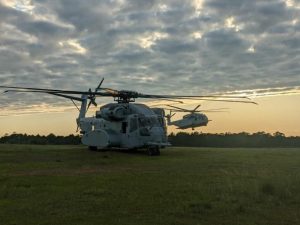The Sikorsky [LMT] CH-53K King Stallion helicopter reached initial operational capability (IOC) on April 22, the Marine Corps said Monday.
The service plans to deploy the first CH-53K Marine Expeditionary Unit (MEU) detachment in fiscal year 2024, which will set the initial conditions for sustained CH-53K deployments in support of MEUs.
The announcement noted, as outlined in the Marine Corps Commandant’s Force Design 2030 Annual Update, the CH-53K will complement connectors enabling littoral maneuver and also provide logistics support to a more disaggregated naval force.
Beyond meeting IOC requirements, the helicopter finished an initial operational test and evaluation period with over 3,000 mishap free hours flown in “various challenging environments and terrain,” the Marine Corps said.
The helicopter is a heavy lift sea-based aircraft that provides almost three times the lift capacity of the legacy CH-53E helicopter. It has the ability to transport the full amount of the vertical Marine Air-Ground Task Force (MAGTF), the Marine Corps said in a statement.

The CH-53K also has an engine with 57 percent more horsepower and 63 percent fewer parts compared to the CH-53E. The announcement said this means it has “an expanded capability to deliver internal and external cargo loads, providing the commander a mobility and sustainment capability the MAGTF has never had before.”
“My full confidence in the CH-53K’s ability to execute the heavy lift mission is the result of successful developmental and operational testing conducted by Air Test and Evaluation Squadron (HX) 21 and Marine Operational Test and Evaluation Squadron (VMX) 1,” Deputy Commandant for Aviation Lt. Gen. Mark Wise said in a statement.
“The success to date of the CH-53K is a reflection of the hard work and effort by the Marines, sailors, and civilians at VMX-1, H-53 Program Office (PMA-261), and Marine Heavy Helicopter Squadron (HMH) 461, and the support we have received over many years from across the Department of the Navy and our industry partners,” he added.
“This declaration is a vote of confidence from Marine Corps leadership and demonstrates the critical role of the CH-53K, giving forces more range and agility to conduct expeditionary heavy-lift assault transport of armored vehicles, equipment, and personnel,” Sikorsky President Paul Lemmo said in a statement.
“This capability is critical in the Indo-Pacific region and around the globe in support of the joint force and allies,” he added.
The Navy’s latest budget request has the service seeking to procure 10 full rate production Lot 7 King Stallions in FY’23 at a cost of $1.7 billion plus another $368 million in advance procurement.
The Marine Corps’ unfunded priorities list sent to Congress with the budget request also has the service seeking two more helicopters in FY ‘23 for $250 million (Defense Daily, April 1).
According to the budget document, over the following four years the Navy plans to procure another 16 in FY ‘24, and 21 each year from FY ‘25 to ‘27.
The Navy also submitted a legislative proposal for a block buy contract for Lot 7 and Lot 8 aircraft over FY ‘23-’24 for 30 helicopters. It would also allow the Navy to enter into a block buy contract across FY ‘23-’24 for 90 CH-53K engines in support of the 30 aircraft. This proposal aims to achieve about five percent savings on airframe and engine costs.
The Navy and Marine Corps have procured 40 units in previous years and plan to buy another 68 after FY ‘27 to reach the final total expected buy of 196 CH-53K helicopters in regular Navy aircraft procurement funds plus four previously procured as system demonstration test articles using research and development funds.
Last year, a Sikorsky official said the company was delivering each helicopter about once every three months and when they were in full-rate production expected to deliver two aircraft per month. They expected international orders to add to that and ultimately reach delivery of three CH-53Ks per month, capacity for 36 per year (Defense Daily, Aug. 4, 2021).
In 2021 the State Department approved a potential $3.4 billion deal with Israel for it to buy 18 CH-53Ks to replace the country’s legacy CH-53D Yasur fleet (Defense Daily, July 30, 2021).
Then late last year, the Israeli Air Force signed a Letter of Acceptance with the U.S. to procure the CH-53Ks with deliveries expected to start in 2025 (Defense Daily, Jan. 4).
Following that signing, the Navy awarded Sikorsky a $372 million modification to deliver four low-rate initial production Lot 6 CH-53Ks for Israel (Defense Daily, Feb. 16).
Also in 2021, Lemmo said they were looking at Germany potentially becoming the second international customer of the helicopter, with a decision expected in 2022. The company plans to sell at least 300 aircraft when combining U.S. and international sales (Defense Daily, Oct. 15, 2021).
The Marine Corps was previously expected to make a full-rate production decision in FY ‘23, first scheduled deployment in FY ‘24 and reach full operational capability in 2029.